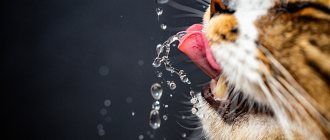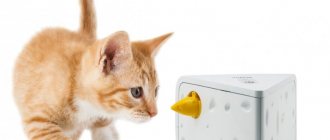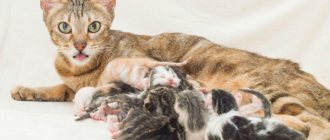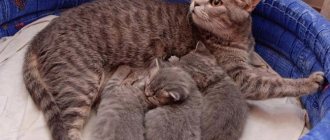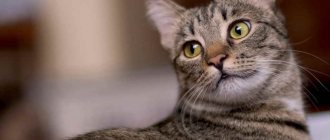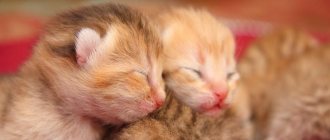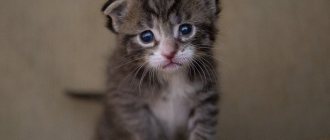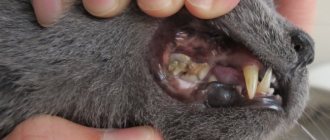Every owner of a mustachioed pet should know how much water a cat should drink per day. Failure to comply with the norm recommended by veterinarians is dangerous and can lead to unpleasant consequences. To avoid them, it is important to calculate your actual fluid intake and bring it to the required level using a few tricks.
What affects water consumption
The daily water requirement for a cat is individual. With age, due to a slowdown in metabolic processes, it gradually decreases. A larger deviation is typical for pregnant pets - when carrying kittens, part of what they drink is transformed into the amniotic sac and milk.
In addition to age and physiological condition, it is necessary to take into account several more important factors: the type of feeding, the mobility and size of the animal, as well as the climatic conditions in the place of residence.
Nutrition
When feeding natural food, up to 75% of the liquid comes from food. The cat gets moisture from fermented milk products, vegetables, herbs, cereals, meat and fish.
With dry granules, the animal receives only 10% liquid. To maintain water balance and comfortable digestion of food, you need to drink a portion that is 2 times the volume of what you eat. Otherwise, an increased concentration of proteins and minerals may result in the formation of stones (kidney or bladder stones).
Body type and activity
The greater the mass of a mustachioed pet, the less its norm per kilogram. Calculation formulas for a miniature cat weighing only 2 kg and a large cat whose weight exceeds 10 kg will be different. In absolute terms, an animal with a powerful physique will have to drink more, but in relative terms, the need will be higher for those who are smaller.
In addition to size, daily activity is also important. Cats that roam freely on the street expend more energy and moisture reserves than those that spend almost the entire day on the couch.
Ambient temperature
Increased human sweating plays an important role in thermoregulation. Thanks to sweat, people can tolerate heat much more easily than pets. In the cat family, sweat glands are located on the pads of their paws - this is why wet marks from cat paws appear on the floor in the summer.
To lower their body temperature, mustachioed pets lick themselves more often, covering their coat with copious amounts of saliva. When it evaporates, a short-term cooling effect occurs. Accordingly, the cat drinks more than normal to produce a copious amount of saliva.
The higher the ambient temperature and the drier the air, the faster moisture is lost. In damp and cool weather the situation is reversed.
Why is water so important to animals?
Despite the fact that up to 70% of a mammal's body consists of water, it constantly needs to be replenished from the outside. It is found in the blood, muscles, bones and is involved in the most important internal processes:
- delivers oxygen to cells;
- maintains a constant body temperature;
- lubricates joint tissues and mucous membranes;
- dissolves nutrients, facilitating the digestion and absorption of food;
- removes toxins from the body that accumulate in waste products;
- humidifies the air in the lungs.
Prolonged lack of moisture leads to a reduction in urination and increased urine concentration. This is fraught with the development of urolithiasis, cystitis and kidney pathologies. If you do not give your pet the recommended amount of fluid, he may get sick or die from dehydration.
Norms of fluid intake per day under different conditions
Felinologists have established that the daily water requirement for an adult cat is 20-40 ml per 1 kg of weight. The indicator is adjusted up or down depending on the previously listed factors. For kittens, the estimated amount of ml is increased 2-3 times.
E. G. Grünbaum, German author of the work “Nutrition and Diet of Dogs and Cats,” suggests using more accurate indicators:
- 31.5 ml per 1 kg – for adult animals;
- 77 ml per 1 kg – for pets under one year old.
This option is more convenient for calculations, but less accurate. Cats of the same weight, but with different types of feeding, will have to be given water in different proportions. Otherwise, an animal that eats only “drying” may suffer from stones in the bladder.
Water comes not only from the drinking bowl, but also from other sources:
- broths and gravy from pates;
- well-cooked porridge;
- fermented milk products and milk;
- vegetable and fruit juices;
- raw or boiled pieces of meat, fish and offal.
When wet canned food is included in dry feeding, the amount of moisture received increases to 80%, and when using granules alone, it remains at 10%. The body is also able to synthesize fluids on its own using the food it receives:
- 0.41 ml from 1 g proteins;
- 1.07 ml from 1 g fat;
- 0.55 ml from 1 g carbohydrates.
Thus, the amount of water per day for a cat eating natural food or wet canned food will be less than that of a “cracker” lover.
Despite this, it should not fall below the minimum value (20 ml per 1 kg of weight). This amount is necessary to maintain basic life processes.
When feeding “drying”, proceed from the amount eaten. If your pet eats 55 g, then he will need at least 110 ml.
Choosing a convenient drinker
Your cat should have access to fresh, clean water around the clock. Make sure that the amount in the bowl is approximately 50% higher than your pet’s daily requirement. This is especially true for animals that eat dry food: the granules swell after ingestion, causing extreme thirst.
It is advisable to pour water into a wide bowl so that the cat does not experience discomfort from the whiskers touching its edges while drinking. A ceramic or glass container is most preferable. In a shiny metal bowl, water can create reflections that will distract or even frighten your cat. If your pet has running water, buy him a drinking fountain.
The water bowl should be washed daily, and in summer - two to three times a day.
Why does a cat drink more or less?
Deviation from the norm is dangerous in both directions. If your pet drinks too little, he is at risk of dehydration, and if he drinks too much, he may develop kidney failure or diabetes.
Extreme thirst
While maintaining good health, severe thirst is explained by pregnancy, overheating, dry air and excess salts in the diet. The first reason goes away on its own, the second is eliminated with the help of a fan and frequent wetting of the animal with a spray bottle, the third is by purchasing a humidifier, the fourth is by revising the diet in favor of better quality feed.
If none of the above reasons apply, then it is better to have the animal checked by a veterinarian. In the presence of pathology, accompanying symptoms may appear:
- reduction or frequency of urination;
- darkening of urine and the appearance of a strong ammonia odor;
- temperature increase;
- refusal to eat and loss of activity;
- the appearance of blood in urine.
Based on the results of the studies, the pet may be diagnosed with kidney disease, liver disease, purulent inflammation of the uterus, diabetes mellitus or a viral infection. A lack of minerals can also cause severe thirst. In this case, the animal may begin to eat soil from pots with indoor plants.
Water refusal and dehydration
If a kitten drinks little water, it may die within the first day. Adult animals with dehydration die only on the 3rd day, but this is not a reason to avoid the veterinarian when the first alarming signs appear. These include:
- drying of the mucous membranes of the mouth, lips and nose;
- slow alignment of skin folds after they are crushed with fingers;
- dry wool;
- lethargy and lethargy up to loss of consciousness.
At home, you can try to give the cat a drink from a syringe without a needle, but it is better to take him to the veterinary clinic right away. Vital signs are stabilized with infusion therapy (droppers).
In addition to the listed signs, a sick pet may exhibit other accompanying symptoms: diarrhea, vomiting, fever. They may be the result of illness or prolonged stress.
If the animal is fine, but refuses to drink the prescribed amount, pay attention to the quality of the dishes and water. The presence of dirt or a strong smell of plastic is unacceptable.
Forced additional soldering
If there is a painful condition, the cat should be taken to the veterinarian. If a healthy pet drinks little, then dehydration of the four-legged body can be prevented by supplementing it with water.
Take a syringe with a volume of 10-20 milliliters, fill with water, and replace the needle with a silicone nozzle. To force the cat to open its mouth, place your palm on its head and press the area behind the fangs with your thumb and forefinger. When the animal opens its jaws, insert the syringe nozzle into the gap and supply water in small portions. The animal's muzzle should be slightly raised, and the syringe should be positioned at an acute angle to the head. The water should not go directly into the throat, but behind the pet’s cheek, otherwise the cat may choke. Make sure he has time to swallow. If your cat coughs, let him catch his breath.
Not all animals take this procedure calmly. If your pet actively resists and uses its claws, swaddle it in a towel, leaving only its head free.
How to measure how much water a cat drinks per day
Use a measuring cup to measure. Pour into it a little more (allowing for evaporation) of the recommended amount and pour everything into a bowl. At the end of the day, pour the remaining liquid back into the glass and subtract this amount from the original. Be sure to add extra volume if the bowl had to be refilled.
During the experiment, avoid contact with the toilet and taps, where the cat likes to drink from at normal times. For accurate results, extend the measurements by 3 days. Due to external and internal factors, moisture requirements may vary from day to day.
If your family has several pets, they will have to be temporarily separated from each other. Place subjects in different rooms to avoid confusion in calculations.
You can also use a webcam to track the volume you drink on a recording using a measuring cup. To do this you will need a device with high definition images. Otherwise, it will be impossible to notice the change in divisions.
How to properly water an animal
Getting your cat to drink more than usual is not that difficult. In the absence of pathologies, the reason for rare trips to watering places lies in improper drinking water or questionable water quality. If you understand each of these points, then you don’t have to worry about the health of your mustachioed pet.
Selection and installation of a drinking bowl or bowl
Choose ceramic or glass bowls. Plastic products often leave an unpleasant odor and quickly accumulate bacteria. If the main material is metal, then it can produce glare that frightens or misleads the animal.
When drinking, a narrow bowl can injure the vibrissae, so it is better to take a wider one.
It is also important not to forget about hygiene: the drinking bowl must be washed daily.
If your animal refuses to drink from a bowl, but loves a stream from the tap, buy him a drinking fountain. This device filters the liquid poured into it and enriches it with oxygen. Another option is to install a faucet filter.
Sometimes the problem lies not in the drinker, but in the place where it is installed. Not all animals like to drink in the kitchen. Place filled containers throughout the house and see which one your cat drinks from most readily. Very often, mustachioed pets prefer the owner's cups left unattended. Be prepared to share your supplies for the sake of your pet's health.
Adipsia and hypodipsia
With hyponatremia, regardless of the cause, animals may stop drinking water. Therefore, adipsia induced by these reasons is actually a compensatory mechanism.
Oral health may cause decreased water intake due to mechanical obstructions or pain when drinking.
Adipsia in some cases occurs as a result of poor water quality. It is always important to remember that a cat will refuse water as long as the need for it is satisfied by consuming wet food!

